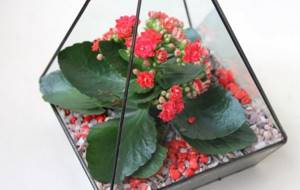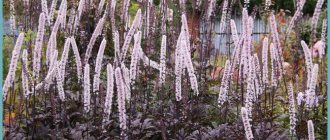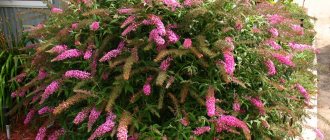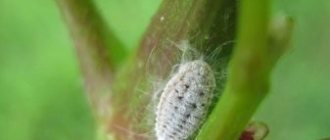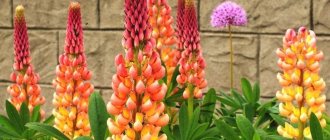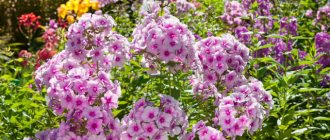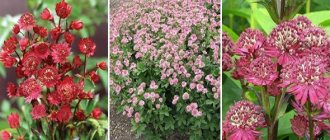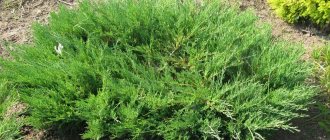Kalanchoe care at home why it dies
If not properly cared for at home, Kalanchoe may develop blooms, as well as brown or black spots if the plant is over-watered at low air temperatures.
High air temperatures and abundant watering can lead to a disease such as powdery mildew.
At high temperatures, leaves may dry out and die, and flowers may not bloom.
In some species, the stems may stretch and become bare - don’t worry, this process is natural.
Also, during the flowering period or in the spring, kaklanchoe may experience such an unpleasant process as the falling of the lower leaves. This indicates the need for additional feeding of the plant.
If your plant is standing in one place on the windowsill and you suddenly notice the appearance of dry brown spots that lead to the leaves falling off, then this indicates the presence of burns. They can be as sunny, or they can be because the plant doesn’t have enough space and needs to be moved to a special stand.
Kalanchoe also has such a dangerous pest as the spider mite. It feeds on plant sap and reproduces very quickly. To combat it, you need to wash the entire plant with a warm solution of laundry soap. A decoction of cyclamen tuber is effective. You can also try using insecticides.
No less dangerous is the scale insect, which also needs to be dealt with in a timely manner. The scale is removed with a brush or a wet sponge soaked in a soap solution. Also in this case, you can use an alcohol solution, but this must be done carefully.
Also, one of the reasons for the death of a plant may be improper care of it immediately after purchase. You must take into account that if the location and conditions change, the plant will experience stress in any case. But subjecting it to yet another stress—a transplant is necessary.
During this process, observe the following rules:
1) do not use the peat in which the plant was kept for sale;
2) use a slightly larger pot;
3) be sure to lay drainage at the bottom;
4) do not rinse the roots, but simply shake off excess peat;
5) carry out the necessary watering;
6) place the flower in a permanent place, in accordance with the conditions necessary for it, and leave the plant alone
Observe your plant carefully and the unpretentious, resilient Kalanchoe flower itself will tell you what it doesn’t like when caring for it at home.
Kalanchoe Bukhara
This species is a medium-sized subshrub native to Madagascar and Southeast Asia. This species is distinguished by a thin, weakly branched trunk, which is not covered with leaves in the lower part. When grown indoors, it does not reach a height of 40 cm. The stems are covered with olive-green wedge-shaped leaves with wavy edges. The upper part of the leaf blade has a gray waxy coating and slight pubescence. Flowering of such Kalanchoe is observed very rarely. It blooms with small pale yellow flowers collected in loose inflorescences. The plant is prone to elongating shoots, so it needs to regularly shorten the top. Caring for the plant involves infrequent watering and plenty of light during the flowering period. Kalanchoe Bukhara is propagated by cuttings, apical stems or using leaves.
Secrets of caring for Kolanchoe
Description and photos of the main types and varieties of spathiphyllum
The thick-stemmed plant can be successfully grown indoors, following certain rules. The key to a healthy appearance and lush flowering of Kalanchoe is the right place to keep it and proper care. The main care for Kalanchoe Kalandiva, as well as for its other relatives at home, is as follows.
Proper watering of Kalanchoe
This is a tropical plant and does not respond well to excess moisture. Constant waterlogging of the soil is the main cause of rotting of the root system of a flower. It is necessary to water Kalanchoe not very often and not in large doses, especially when it has entered its flowering period.
In the spring and summer, the ornamental plant is watered with cool, settled water. When watering a flower, the above-ground part must be protected from water in order to prevent rotting of the stem and leaves. Moderate watering in spring and summer is ideal for this flower. When overflowing, excess water from the pan must be poured out. The optimal frequency of watering Kalanchoe is once every three days.
This flower has a significant supply of liquid in the leaves and trunk, so lack of moisture is not very bad for it. He suffers more from its overabundance.
In the autumn-winter period, Kalanchoe is watered less often. Do not allow water to stagnate in the pan. Excess moisture at low temperatures, which the plant cannot tolerate, can cause its death. Ideally, each watering of this exotic plant is carried out as the top layer of the earth dries out. In winter, the plant is watered with warm water. Watering with cold water can stress the plant.
Lighting Kolanchoe
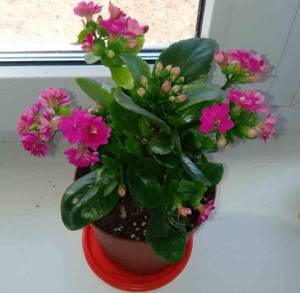
Kalanchoe is a sun-loving plant. Before noon, the flower can be easily exposed in direct sunlight, and after lunch, put away in a shaded place, creating twilight conditions. In order not to move it from place to place every day, you can use the most ordinary light cloth and cover the plant with it. In the afternoon, the sun's rays are extremely dangerous for this flower. They can cause burns to the leaves and stem.
In winter, the plant can be placed in one place without moving it, since the sun is less active at this time of year.
Temperature regime of Kalanchoe
Kalanchoe prefers moderate temperatures ranging from 16 to 20 degrees. But if the temperature drops to 5-7 degrees, this will in no way affect the condition of the plant. This flower does not like heat; it begins to absorb significant amounts of water and suffer from various diseases.
Air humidity
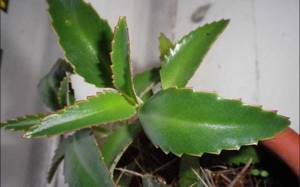
This flower does not need high air humidity. The plant does not like excess moisture not only in the soil, but also in the air. With increased air humidity, its stem accumulates excess moisture, which can cause fungal infections and mold. In winter, the flower must be provided with low air humidity.
Feeding
As for fertilizers, Kalanchoe does not necessarily need to be fertilized. In this case, if the plant suffers from a lack of mineral components, then it is fed with fertilizer for cacti. It must be remembered that feeding Kalanchoe is not carried out during winter.
Even if the plant begins to fade at this time of year, it does not need to be fertilized. Fertilization for Kalanchoe is carried out in late spring - early summer. The concentration of the substance must be two times less than recommended. This is quite enough for the full growth and development of the flower.
Fertilizers are applied in liquid form, having previously dissolved it in warm water. This technique ensures complete nutrition of the roots.
Planting Kalanchoe in open ground at the dacha
Kalanchoe feels good outdoors in the garden, subject to planting and care conditions. Used in flower beds as a solitary plant and in borders (low-growing forms).
What indoor flowers can be taken outside in summer?
Below are the features of the microclimate and agricultural technology necessary to successfully grow Kalanchoe outdoors.
Temperature regime for the plant
Outdoor Kalanchoe is planted after frosts have passed and the soil and air have warmed up sufficiently. In central Russia and the Moscow region, such conditions occur in the first ten days of June. A plant that has overwintered at home must undergo acclimatization: 2-3 days before transplanting, it is taken out into the fresh air for several hours, and on the last day it can be left overnight.
Kalanchoe tolerates air temperatures from 12 °C to 30 °C with virtually no problems. The temperature regime at which the plant is most comfortable is 16 °C to 18 °C.
Important! At extremely low and high temperatures, Kalanchoe stops growing and buds.
Air and soil humidity
The flower is not picky about air humidity. It tolerates drought well at high temperatures and excessive humidity at low temperatures.
Sensitive to substrate moisture. Watering is necessary abundant and regular. If the plant grows in partial shade, the intensity of watering should be reduced. The main thing is to ensure that the lump of earth does not dry out.
Location and lighting
Kalanchoe does not require lighting. The only thing to avoid is direct sunlight, as this can cause burns. With a strong lack of sun, the flowers of the plant will become small and inconspicuous.
Important! The flower must be provided with 12 hours of diffused lighting.
Features of feeding
Kalanchoe, like other succulents, does not respond well to foliar feeding, but responds well to root feeding.
For fertilizing, experts advise choosing complex products. They are easier to dose and contain a full range of macro- and microelements. The following ratio is considered optimal:
- 20% nitrogen;
- 8% phosphorus;
- 20% potassium.
The drug is diluted in water: 5.5 g per 2 liters. Watering is carried out twice a month. At the end of summer, the frequency of fertilizing is reduced, and by autumn it is stopped.
If, 2-3 days after fertilizing, yellow curled leaves appear on the plant, you need to stop fertilizing.
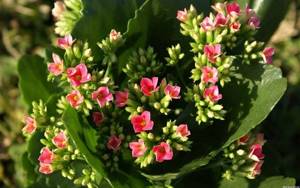
Beautifully flowering Kalanchoe is not particularly picky about fertilizers
Specifics of transplantation
Planting and replanting Kalanchoe are fairly simple procedures. The main thing is to choose a suitable place and correctly compose the soil mixture. Here is the approximate composition of the soil that needs to be filled in the holes:
- deciduous soil - 2 parts;
- turf soil - 2 parts;
- compost - 1 part;
- sand - 1 part.
Important! You need to add charcoal or expanded clay as drainage.
The mixture you prepare yourself can be replaced with purchased soil for succulents.
Flowering period
The many faces of aquilegia, photo of flowers and description of species
Kalanchoe can delight you with abundant flowering almost all year round. To do this, it is recommended to proceed according to the following scheme:
- wait until the plant blooms;
- trim the bush to “stumps”;
- put in a cool, shaded place to rest for 1–2 months;
- the rested plant is given familiar conditions.
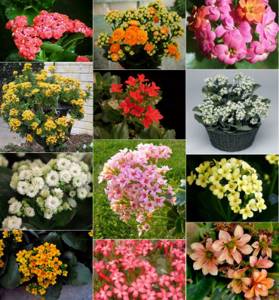
After gaining green mass, the succulent will safely release buds and delight you with lush color. The photo of Kalanchoe clearly shows how beautiful the plant is during this period.
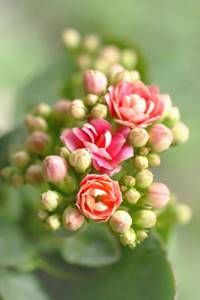
A wonderful plant that energizes and decorates the surrounding space is simply necessary in every home. Such a “pet” is the flowering Kalanchoe.
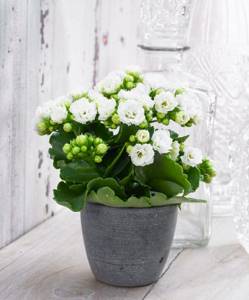
An unpretentious resident with many useful properties will come in handy in any home.
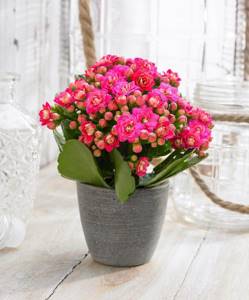
Beneficial properties of kalanchoe pinnata healer in our home
Tamarix shrub - description of species and varieties
Very often in homes there is also a species such as Kalanchoe pinnate, so it is no wonder that people are interested in the medicinal properties of this plant. It is popularly called “doctor” or “room ginseng”, and this is quite justified.
The juice from the leaves has an anti-inflammatory effect and perfectly heals wounds, trophic ulcers, and burns. Usually, problem areas of the skin along the edge are pre-lubricated with a thin layer of synthomycin or furacillin ointment, and then the wound is irrigated with Kalanchoe juice from a syringe and covered with a gauze bandage generously soaked in the juice. It is fixed and left for 5 hours.
An ointment is also prepared from this medicinal plant, suitable for the treatment of bedsores, chronic inflammation of the middle ear, trophic ulcers, and long-term non-healing wounds. Mix 2 tablespoons of fresh plant juice with 2 tbsp. spoons of anhydrous lanolin, several ground tablets of furazolidone and 5 ml of novocaine 2%. The resulting ointment is applied to a sterile bandage and applied to the wound.
Lanolin ointment is also actively used in dental, gynecological and obstetric practice.
Bedsores can also be treated by simply applying a peeled Kalanchoe leaf to them. In this case, you need to secure the bandage and leave it overnight.
For cataracts in the initial stage, apply a paste of Kalanchoe leaves to the eyelids (before bedtime, for an hour), then remove, but do not wash the face at night. For inflammatory eye diseases, it is recommended to instill 1-2 drops of freshly squeezed juice into each eye daily.
Crushed Kalanchoe leaves can be used for melanoma (skin cancer). This paste is mixed with apple cider vinegar (in a 1:1 ratio) and applied to the wounds as a compress.
To get rid of erysipelas, mix Kalanchoe juice and novocaine (0.5%) in equal proportions, smear a gauze bandage with the solution and apply it to the affected area of the skin. Do this 3 times a day for a week.
For ear pain and otitis, make turundas from gauze, wrap crushed leaves in each turundum and insert them into the ears at night. The mixture will draw out the pus and relieve pain.
Kalanchoe medicinal properties
There are a lot of diseases that Kalanchoe treats. This plant is so unique for healing that it can treat almost all of our organs. These are varicose veins, sinusitis, inflammation of the middle ear, flu, purulent inflammation, eyes, teeth and so on.
Kalanchoe has medicinal properties for varicose veins. You probably know that varicose veins are primarily a loss of elasticity of the veins. The veins begin to swell and nodes form. This means that blood supply deteriorates, oxygen starvation of tissues occurs.
As a result, metabolism is disrupted. What to do? And this amazing plant comes to the rescue. How to use it: rub Kalanchoe tincture on your feet. Start at the feet and work your way up the leg.
Within a few minutes you will feel that the pain is receding and the cramps disappear. In order to completely heal your feet, apply Kalanchoe tincture to sore spots for four months.
Kalanchoe has medicinal properties for inflammation of the middle ear. What causes this disease? The skin of the ear canal or pinna is affected by microbes. Because of these pathogenic microbes, the middle ear becomes inflamed (otitis media).
If there is purulent inflammation, instill Kalanchoe juice in your ear, or put a cotton swab soaked in Kalanchoe tincture in your ear. How Kalanchoe juice is made is described above. The tincture can be prepared with either alcohol or vodka (40%). This is also written at the beginning of the article.
Kalanchoe has medicinal properties for sinusitis. Why does this disease come? Most often these are the consequences of the flu, or any other disease associated with infection.
Traditional medicine has long been advising and many people treat sinusitis with Kalanchoe juice. Place Kalanchoe juice in your nose. Tilt your head back as far as you can and squeeze the juice from a fresh Kalanchoe leaf into a pipette and drop it first into one nostril, then into the other.
If you do the instillation correctly, then after a few minutes you will want to sneeze. When you sneeze, your nose and grooves are cleared. After three days of this treatment, your sinusitis will go away.
Kalanchoe medicinal properties are effective in the treatment of gynecology. Kalanchoe juice can be used to treat cracked nipples, cervical erosion, and birth ruptures for nursing mothers.
How to heal ruptures: doctors advise first lubricating the skin around the wound with a thin layer of syntomycin emulsion, or furacilin ointment. Then fold the gauze into five layers, soak it in Kalanchoe juice and place it on the sore spot for a few minutes.
Kalanchoe has medicinal properties for influenza. We all know that the flu is primarily an infection that affects the respiratory system. At the beginning of the disease, we feel unwell, the temperature rises, the head hurts, there is no appetite, the whole body aches, cough, runny nose, etc.
If the flu starts, there can be a variety of complications. This could be bronchitis, radiculitis, pneumonia and even meningitis. Such a folk remedy as chewing Kalanchoe leaves is simply irreplaceable for the flu.
When Kalanchoe juice enters the body, the first thing it does is relieve inflammation of the throat. The runny nose goes away. If you have a stuffy nose, dilute Kalanchoe juice with water one to five and drop two drops into your nose into each nostril. Do this procedure four times. You can also gargle and gargle.
Kalanchoe medicinal properties
for eye diseases. There are a variety of eye diseases. Inflammation of the eyelids, corneal erosion, even eye burns. What do eye diseases originate from: Rheumatism, vitamin deficiency, metabolic disorders and even tuberculosis. Injuries also play an important role.
Even in ancient times, people used plantain, sorrel, garlic, rose hips and, of course, Kalanchoe for treatment. To treat the eyes, people most often use Kalanchoe juice both before and now.
There are many more different tips and ways to treat a variety of diseases with such a wonderful plant as Kalanchoe. I really hope that these tips for treating Kalanchoe will be useful and help you.
Be healthy.
Kalanchoe care at home
How to water a plant correctly? During the warm period (spring, summer), we water the Kalanchoe with cool water, just do not touch the stem; if water gets in, the process of rotting may begin. If you accidentally overfilled it, don’t worry, we immediately empty the pan of liquid. Take note: try to control the watering process; Kalanchoe can easily remain without liquid for 2-3 days. Why? Let's reveal a little secret: the plant contains a small supply of liquid. In cold times (autumn, winter) water 2 times less. Has difficulty withstanding frost.
Illumination. Almost any place in the house where sunlight falls is suitable for the plant.
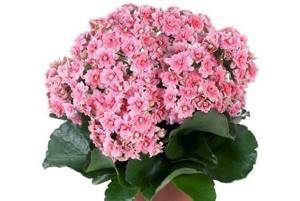
Temperature. As for the temperature regime, everything is very simple here: the optimal option in summer is 20-23 C, in winter – 11-15 C. In extreme heat, the plant feels unwell; to prevent this from happening, increase the frequency of watering.
Humidity. It is not advisable to keep Kalanchoe care in a room with high humidity levels. Excess liquid in the stem can lead to mold and mildew. To get rid of dust, wipe the leaves with a cloth so that various parasites do not appear on the surface.
Fertilizer. If you notice that the plant needs minerals, then choose succulent fertilizers. The best period for feeding is the end of spring (as an extreme case - mid-summer). We use 2 times less fertilizer than is written on the package. In winter, you cannot feed. Remember, be sure to dissolve the fertilizer mixture in warm water, cool it a little, and only then add it to the bud.
How to properly transplant Kalanchoe (care at home). It grows quite quickly, so it needs frequent replanting - once a year, at the end of March. How does this happen? Carefully separate and transplant into a new pot 3-4 cm larger than the previous one. After that, the adaptation process begins. And don't forget to feed the flower. After 7-8 days the plant takes root completely.
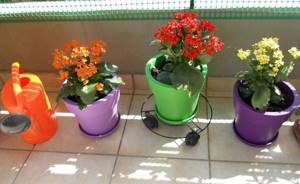
When does Kalanchoe bloom? Flowering occurs once a year at the end of winter, and ends in the 1st month of spring. If for some reason the plant does not bloom, it is worth checking for the presence of parasites and fungus.
Answers to frequently asked questions from readers
Tell me why Kalanchoe does not grow? One of the most common reasons is a lack of nutrients. You should transplant the flower into another pot and follow the rules of caring for the plant.
What to do if the leaves turn yellow? Kalanchoe leaves If you notice that the upper leaves have begun to turn yellow and the lower leaves have fallen off, then the reason for all this is the lack of sunlight. If the leaves turn yellow along the entire stem, then you should reduce exposure to sunlight - move it to a neutral place.
Kalanchoe does not bloom. In this case, we gradually reduce the amount of fertilizer in the soil.
What to do if the plant dries out? The main reasons: insufficient amount of liquid in the soil (long period), parasites in the root system and unsuitable soil composition.
Features of care
Caring for a flower at home will not cause any difficulties. Kalanchoe reproduces:
- By cuttings,
- By budding
- By sowing.
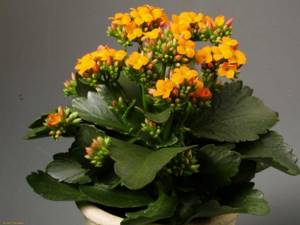
Even cut leaves can be buried and after a while roots will appear, the flower will not die, it will continue to grow and develop. Therefore, when a plant begins to lose its decorative effect, it is better to prune it and plant it. It is better to do this after flowering in order to immediately remove the dried inflorescences.
Read here Portulacaria: types, care rules, breeding features and transplanting succulents at home (105 photos)
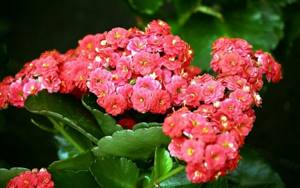
On the fleshy leaves of Kalanchoe, along their contour, small plants, ready for planting, are constantly formed - children. They can be dug in and watered (sprayed) with a spray bottle. They will take root easily.
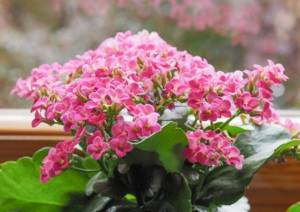
Also, when caring for a plant, you need to pay attention to the following points.
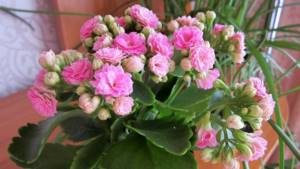
Care and propagation of indoor Kalanchoe flowers
Kalanchoe flowers are propagated by seeds, cuttings or brood buds.
To get a sprout, just cut a leaf, turn it upside down and stick it into the ground. The soil should be a sandy mixture or a useful substrate, the layer thickness of which ranges from 15–20 cm (depending on the depth of the container). It is preferable to prepare a planting mixture from garden soil diluted with humus and sand (1:1:1). The soil temperature should be around 20–25 °C. The planting distance between plants should be 10 cm.
When reproducing by brood buds, everything happens on its own. Children also appear in fairly young plants. If your flower has grown to about 10–15 cm and has acquired a fairly dense stem and thick leaves, in other words, has entered into force, you can expect offspring - small sprouts. With such propagation and sufficient care, Kalanchoe sprouts take root easily and quickly, since the thinnest root threads hang under the tiny stem
When the young sprout reaches 1–1.5 cm, it can be carefully removed from the ground and planted in a separate pot. The adaptation period in a young plant is very easy
Within a week or two you will notice that the little Kalanchoe has grown. For the first 2–3 weeks, a newly rooted plant needs to be watered a little more often than an adult plant - 3 times a week in small portions. An adult plant is watered 1-2 times a week. Remember that Kalanchoe accumulates moisture in its stems and should not be watered too much.
Below you can see photos, names and descriptions of Kalanchoe species cultivated at home.
Beneficial features
The Kalanchoe flower has been famous for its healing properties since ancient times. It is actively used in:
- Dentistry for the treatment of stomatitis, periodontal disease and gingivitis;
- Surgery, for severe burns, bedsores, trophic ulcers and long-term non-healing wounds;
- Gynecology, with cracked nipples and postpartum tissue ruptures;
- Cosmetology, for skin rejuvenation.

Possessing low, almost zero toxicity, Kalanchoe does not cause irritation to the skin and mucous membranes. At home, its juice (squeezed from the leaves) can be instilled into the nose to ease breathing during colds and runny nose, and also (diluted with clean water) rinse the mouth for diseases of the teeth and gums to relieve swelling and inflammatory processes.
Reproduction methods
Propagation of Kalanchoe by cuttings
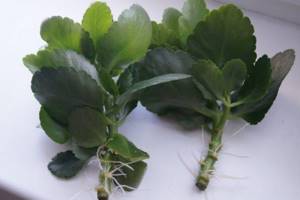
Both a leaf plate and a shoot segment can be used as a cutting. Rooting them is very easy. For example, in the first weeks of summer, tear off a leaf from the parent bush and plant it in a fertile soil mixture. Then it is covered with a jar and periodically moistened with a sprayer. After a little time, roots form on the leaf.
Growing from seeds
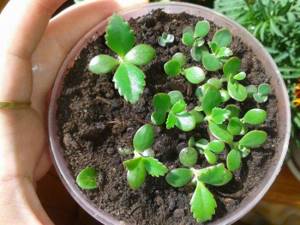
The crop is also quite easy to propagate by seeds. They are sown in the last winter or first spring weeks. To do this, take a container that is filled with deciduous soil. Then you need to evenly distribute the seeds on its surface, which are then pressed into the substrate with your finger, and there is no need to fill them with soil mixture on top. The container must be covered with glass and a paper sheet; crops need regular ventilation in the morning and evening. They need to be provided with the correct temperature regime from 16 to 20 degrees, as well as timely watering with lukewarm water, while making sure that it does not dry out completely. After the shoots appear, the cover must be removed from the container. When they are 20–30 days old, they should be put into a larger container. The plants are replanted again after their third or fourth true leaf blade has formed. Do not forget to make a good drainage layer at the bottom of the pots, and for planting seedlings use a substrate consisting of turf soil, peat and sand (2: 4: 1). After the transplanted seedlings have taken root well, they should be pinched at the top, thanks to which the bush will be more lush and branched. The next transplant is carried out only after the plant becomes cramped in the pot. This time they use a soil mixture that includes humus, compost, sand and deciduous soil. The young bush will bloom for the first time next year.
Where and how to plant?
The operation of planting already mature flowers or still very young shoots is quite simple and can be done at home. To do this, you need to create open ground on the street yourself. But you can purchase ready-made substrate in the store .
In order to make the soil yourself you need to take:
- Four parts of deciduous soil.
- Two parts of turf land.
- One part compost.
- One part sand.
You should also add charcoal or drainage to the substrate . If there is no desire or time to create soil for the future plant, then, as mentioned above, it can be purchased at flower shops. The soil must be chosen special for succulents. It is he who will be able to retain moisture for a long time. In addition to this soil for succulents, you can also use universal soil, but be sure to add coconut fiber or a little perlite to it.
If you replant with cuttings, this will be the most favorable for the plant, since new plants will quickly appear. For this procedure, it is necessary to cut off the stem of a small plant from an adult plant and place it in a container with water at room temperature for roots to appear.
It would not be superfluous to add 2 tablets of activated carbon to the same container with water to avoid rotting. To do this, cut off a small stem from the parent flower and place it in water to form roots. You can also add two tablets of activated carbon there to avoid rotting.
Lighting and location
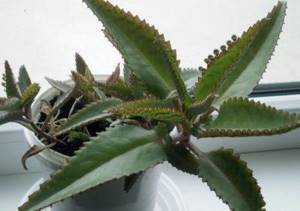
Do not allow direct exposure to sunlight - this can lead to burns on its leaves. If there is a lack of lighting, the plant will stretch out, and its buds will become small and inconspicuous.
One of the most important points for caring for this plant is twelve-hour lighting. In order for the plant to grow and develop quickly, as well as to have abundant flowering, it is necessary to provide the plant with additional lighting in winter.
Soil requirements
Any soil for succulents , which can be purchased at flower shops, is suitable for Kalanchoe. If desired, you can make the soil mixture yourself by taking equal parts of leaf and turf soil, peat and sand. It is advisable to add charcoal or perlite to the mixture. There should be drainage at the bottom of the pot.
How to grow Kalanchoe at home
Growing. Kalanchoe does not require special care, so growing it will not be difficult. The pot should be spacious to provide ventilation to the roots. The soil should always be slightly moist. It is better to grow not in the ground, but in special peat soil with the addition of sand, humus and leaves.
Bloom
With proper care, Kalanchoe blooms for 6-8 months a year, and it is important to consider that the duration of flowering of this plant depends on the exposure to sunlight. Therefore, during this period, Kalanchoe must be exposed to light - this stimulates the appearance of new buds
Flowers should be trimmed as they fade.
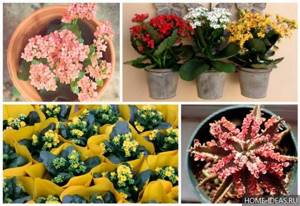
Transfer. Kalanchoe needs to be replanted once a year with the onset of spring. This should be done only after the flowering period has passed.
The plant should be carefully removed from the pot and transplanted into another container, which should be larger in size than the previous one.
Reproduction. Kalanchoe propagates by seeds and cuttings, and it is better to use the second method
To do this, it is necessary to cut off a shoot from an adult stem and set it aside for several days - this is necessary for dehydration. Next, the cutting should be placed in the soil, where it will soon take root.
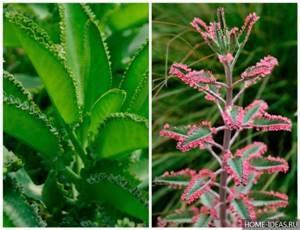
Basic information about Kalanchoe
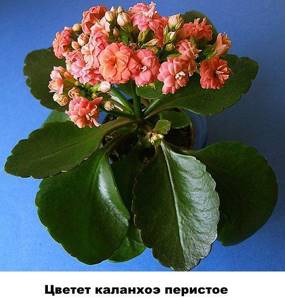
In order for a plant to thrive under artificial conditions, it is necessary to create conditions similar to natural ones. The fact that Kalanchoe is a succulent, a plant with thick, fleshy leaves, indicates its drought resistance. A resident of desert lands, he collects moisture and carefully stores it. The juice of this plant has more than once saved aborigines who found themselves in the desert without water.
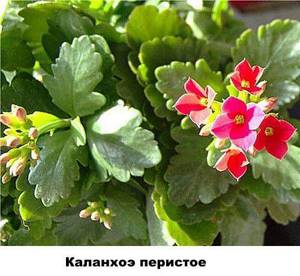
In order for a plant to bloom in cultivation, it must create the following conditions:
- the soil is light, with a lot of sand and stone chips, sour;
- watering is moderate, almost scanty;
- provide a period of rest;
- regulate the length of daylight and temperature;
- regularly prune and feed;
- replant on time.
The plant blooms in winter for several months, later gaining strength and entering a dormant period. In order to achieve abundant, long-lasting flowering, maintenance conditions must be observed. The intricacies of agricultural technology are generously shared by those who understand this plant and can persuade it to bloom by any significant date.
Kalanchoe flowering is both a medicinal plant and an ornamental one. Its leaves and stem are used in folk and traditional medicine. This plant is represented by two species - pinnate and Kalanchoe Dergemona. The species differ in that on their jagged leaves they form babies, miniature plants with ready-made roots. Having come into contact with the ground, the baby takes root without difficulty. In another way, such plants are called Kalanchoe viviparous.
Kalanchoe Rosalina makes you spend hours admiring the generous blooms for several months. The hobbyist needs to remove the faded buds from time to time, making room for new flower stalks. These flowers are propagated by seeds or cuttings. Rooting should be done in damp sand in a mini-greenhouse.
Kalanchoe Kalandiva photo amazes with its victorious flowering in conditions so far from natural. But the vital forces of the plant are so all-conquering that in the smallest container, on a window in the middle of winter, a miracle blooms. This variety of plant has short flower stalks, and the head of flowers barely rises above several fleshy leaves. The dwarf plant does not require much space on the windowsill.
Kalanchoe mini mix are small bushes that can create a picturesque carpet with different shades. Plants look amazing on the balcony or windowsill. The composition of several plants of different colors in one pot is especially unusual.
Kalanchoe Blossfeld is represented by many varieties, different colors. The stems of this plant are smooth, up to 40 cm tall. The leaves have teeth. This type of Kalanchoe blooms for six months in the summer months. The rest period is from November to February.
Kalanchoe Laciniata differs from its relatives in having strongly dissected leaves. They present fleshy branches reminiscent of the antlers of young deer. Just as tender and saturated with healing juice. Under the weight of the juice, the tender leaves gradually bend down and the plant can be considered ampelous and used in wall compositions. The flowers of this species are tubular, arranged sparsely, but look delicate in the composition. Another name for this flower is Kalanchoe deer horns.
Kalanchoe dissected is another name for Leciniata. Not everyone can achieve flowering of this plant. But for its tolerance, for its ability to live next to the dry air of indoor radiators, it is used in compositions on the eastern window. The flower is unpretentious, but if watered excessively it can rot. In addition to the usual methods, it also reproduces by aerial roots. Having cut off the petiole, it can be rooted immediately.
Kalanchoe Rosaflowers is a new hybrid crop about which there is little information, but the appearance of the flower makes you freeze from the amazing combination of delicate shades and the beauty of the opened bud. The plant is not tall, while it is a resident of greenhouses in which this species breeds. Reproduction is carried out by cuttings.
Kalanchoe Beharskoe is a bush with bluish leaves of an unusual shape. They can be bluish or green with drooping. This plant blooms in midsummer, throwing out a loose panicle of light yellow color. Since the leaves on the trunk fall off, for decorative purposes the top needs to be cut off and rooted from time to time.
Kalanchoe tomentosa grows up to 40 cm in height with very closely spaced fleshy felt leaves. This succulent blooms in July, the flowers are white or slightly pink. Brown spots are present at the tips of growing leaves.
Types of Kalanchoe with photos
The genus has about 20 species. Many types of Kalanchoe are grown at home.
Kalanchoe blossfeldiana
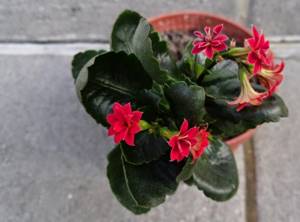
This species is famous for its numerous flowers collected in an umbrella inflorescence. The flowers are located on long stalks and come in a variety of colors. The plant is very unpretentious to care for.
Kalanchoe manginii
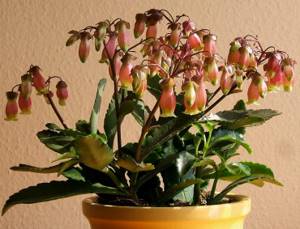
Ampelous look. The flower is miniature (up to 15 cm) and is distinguished by exotic inflorescences resembling small bells. Flowering usually occurs in spring.
Kalanchoe daigremontiana
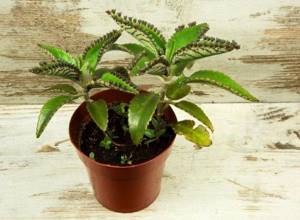
This species blooms quite rarely exclusively in winter. The height of the plant reaches 50 cm. It has a straight stem and long (up to 10 cm) green triangular leaves. The leaves are covered with many purple spots.
Kalanchoe pinnata
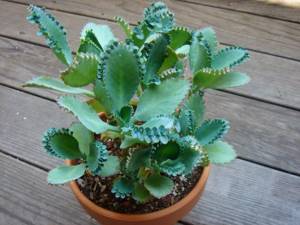
It is considered the hardiest species. It is distinguished by its height, reaching 1 m. The color of the flowers is unusual: white tones, smoothly turning into green. The juice of this type of Kalanchoe is sold in pharmacies.
Kalanchoe bentii
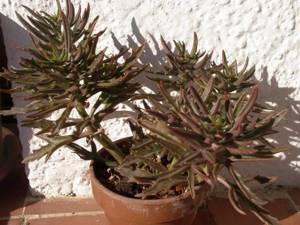
The species is represented by subshrubs reaching a height of 1 m. Platinum leaves are up to 50 cm long, quite thick and weighty. White flowers are collected in umbrella inflorescences. Flowering occurs in mid to late spring. Tolerates cultivation well in cool rooms.
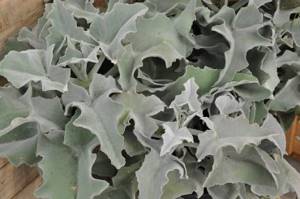
The species is represented mainly by shrubs. The leaves are serrated and covered with small hairs.
Kalanchoe tomentosa
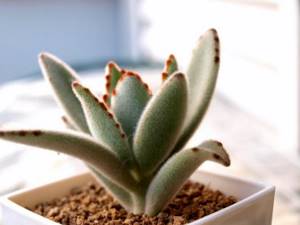
Representatives of this species are subshrubs. The stem is erect, the leaves have small hairs. Miniature flowers are collected in umbrella inflorescences.
Kalanchoe grandiflora
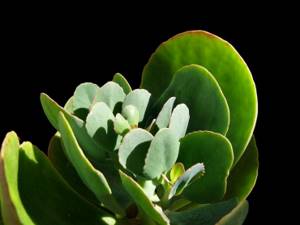
The species is also known as Kalanchoe marmorata. These are mainly subshrubs reaching a height of 50 cm. The leaf blades are green. In direct sunlight, the leaves may turn pale red. The yellow flowers are collected in an umbrella inflorescence and have a pleasant aroma. Flowering begins in late spring.
Kalanchoe thyrsiflora
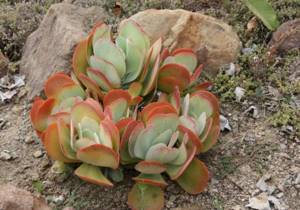
Plants of this species reach a height of 50-60 cm. At the base, the leaves are arranged densely; closer to the top, the leaves become smaller and sparser. The flowers are yellow in color. Flowering occurs in late spring.
Kalanchoe flammea
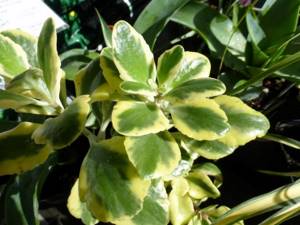
The species is known as Kalanchoe glaucescens. The height of the plants reaches 40 cm. The leaf blades become wider and larger closer to the top of the plant. The leaves are round and green with white edges. Orange flowers are collected in umbrella inflorescences.
Kalanchoe tubiflora
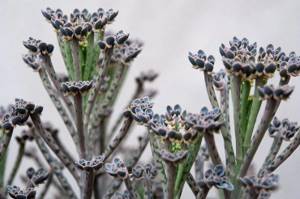
The species is represented by subshrubs reaching a height of 70 cm. The leaf plates are gray-green in color and have a narrow, elongated shape. The leaves of the plant are covered with brown spots.
Kalanchoe dissected (Kalanchoe laciniata)

The species is also known as Kalanchoe lobata. The stems of the plant eventually sink down under their own weight, shedding leaves at the base. The green leaves have a dissected shape. The flowers are yellow or orange.
Kalanchoe Kalandiva
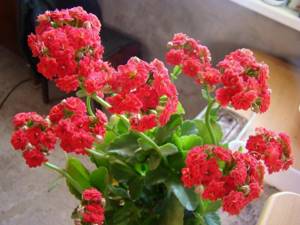
The species was obtained through selection. It is distinguished by its modest size and six-month flowering period.
The Kalanchoe plant is easy to care for at home, even beginners can do it. If you follow certain rules, the flower will constantly delight you with its appearance and beauty.
Cacti and Succulents Indoor Plants
Kalanchoe Pinnate
A distinctive feature of this species is that it is used in folk medicine as a medicine. Each type of Kalanchoe has some of its own healing properties, but Cirrus is endowed with them to the greatest extent. In addition, this plant has a very beautiful decorative appearance, allowing it not only to be beneficial as a medicine, but also to decorate your window. In the wild, you can see Kalanchoe pinnate in Southeast Asia or America. In the natural fauna, it can grow up to one and a half meters in height, but when grown indoors, it is a low shrub with an erect stem of a fleshy structure, which has a woody lower part. The leaves are large, elliptical in shape with wavy edges. The upper leaves are pinnately dissected, oval-shaped, dark green in color, and may have a red or yellow tint. This type of Kalanchoe is also “viviparous” and grows “babies” along the edges of the leaf. Flowering begins when the plant reaches two years. The flowers are large, pink-green in color, located on the tips of the shoots in paniculate inflorescences. Flowering occurs irregularly. After flowering, a leaflet is formed - this is a fruit that can be used to propagate this type of Kalanchoe. Growing such a plant at home is not particularly difficult. It is recommended to add complex mineral fertilizers to the soil and moisten the flower only after the earthen ball has formed. The plant does not like drafts and direct sunlight.
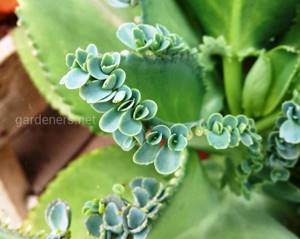
Medicinal properties of Kalanchoe leaves
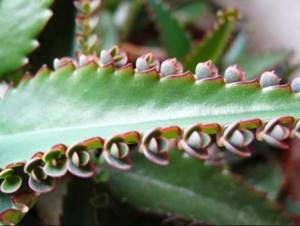
For medicinal purposes, Kalanchoe leaves are used, from which the juice is squeezed. The shoots and juice contain:
- flavonoids (kaempferol, gelaline);
- polysaccharides;
- triterpenoids;
- sterols;
- bufadienolides;
- tannins;
- catechins;
- lectins;
- enzymes;
- organic acids (malic, lactic, acetic, oxalic, citric, isocitric);
- starch;
- amino acids (phenylalanine, alanine, threonine, etc.);
- microelements (zinc, magnesium, etc.);
- vitamins.
Through experiments, it was found that if picked Kalanchoe leaves are kept in a dark, cool place for a week, the amount of biologically active substances in them increases by half. Therefore, it is recommended to keep the leaves in the refrigerator for at least several days before using.
Thanks to a unique combination of chemicals, Kalanchoe has a wide range of therapeutic effects. Here is a short list of its properties:
- bactericidal;
- choleretic;
- anti-inflammatory;
- bacteriostatic (stops the growth of bacteria);
- astringents;
- hemostatic;
- wound healing.
Kalanchoe Degremona is famous for its analgesic effect, it is effective for ulcerative pain, tuberculosis, wounds and ulcers. For burns, it is effective to lubricate the affected areas of the skin with juice diluted with egg white.
To prevent influenza, the juice is instilled into the throat and nose (5 drops each).
In gynecological practice, for cervical erosion, vaginal applications are made with Kalanchoe juice (for two weeks). For mastitis, it is recommended to lubricate the nipple areolas with juice (2-3 times a day), and also apply warm compresses to the breasts at night.
Kalanchoe juice helps with inflammatory processes in the kidneys and stomach problems. In parallel with drug therapy, in this case it is prescribed to drink a teaspoon three times a day.
It is also useful to drink juice for tuberculosis: a teaspoon of juice is diluted in half with boiled water and consumed after meals twice a day.
Water infusion of Kalanchoe is used to treat inflammation of the eyelids, skin diseases, gargling for colds, and gums for periodontal disease. It is prepared like this: one part of the crushed leaves is infused in six parts of water (6 hours), then boiled for 2-3 minutes. The finished infusion is filtered through a fine sieve or cheesecloth. For skin diseases, the infusion is used in the form of compresses and lotions; for chronic colitis and gastritis with low acidity, the infusion is drunk 2-3 times a day (for a month) half an hour before meals.
For gastritis, you can simply eat a Kalanchoe leaf; it perfectly heals internal ulcers and wounds.
For psoriasis, the leaves are crushed and this pulp is applied to the wounds, fixing everything with a bandage. The same is done for warts; it is noticed that after the third procedure, the warts disappear. A paste of Kalanchoe leaves is applied to sore knees (at night) and for bursitis.
A mixture of Kalanchoe and celandine juices (1:1) is also effective for psoriasis. A sterile gauze pad is soaked in the solution and applied to the problem area of the skin for 2-3 hours.
In case of mental and physical fatigue, it is enough to chew a Kalanchoe leaf and after half an hour your performance will be restored.
According to herbalists, it can slow down the process of tumor development; you just need to eat a leaf of the plant every day on an empty stomach. Do this for 3 days, keeping the leaves in the refrigerator first. A month later, repeat everything.
Reproduction of Kalanchoe
Can happen in three ways:
Reproduction by apical shoots
It is better to cut cuttings in the spring after the plant has flowered; their length should be approximately 8-10 cm. The roots need to be strengthened in peat or sand, covered with polyethylene. After some time, it is necessary to ventilate and spray the sand, the temperature should be approximately 21 ° C. Cuttings whose root system is sufficiently strengthened are transplanted into pots.
Reproduction by separate leaf
It is considered a simpler option, because for this you only need healthy leaves from the plant, and the bottoms of plastic bottles are suitable as containers for rooting. You will also need pebbles to create drainage and peat. We make several holes in the bottle and place pebbles in one third of the container. Then the soil is laid out, where the leaf blades are placed for rooting.
Growing Kalanchoe from seeds
They are sown in a container with leaf soil with the addition of sand at the end of winter. The temperature at which the seeds will germinate should be between 20-22 °C. If the seeds are fresh, their germination can be observed in one to two weeks. After this, you need to transplant the seedlings into separate containers and expose them to light - this has a beneficial effect on the nutrition and growth of Kalanchoe.
The healing properties of Kalanchoe in cosmetology
Self-care is something that requires system and consistency. The traditional care package includes cleaning, moisturizing and nutrition. Kalanchoe has cosmetic properties that can provide any beauty with everything she needs.
- Wipe your face with a Kalanchoe leaf after washing. Before the procedure, you need to remove the skin from the leaf. Rub and massage lightly into skin. After this, lubricate your face with your nourishing cream. The procedure is designed for skin of any type.
- If you are tired of black dots on your face, do the following procedure systematically. Wash with warm water, slightly salted. Then they wipe the problem areas with a hot swab, soaped and sprinkled with fine salt. 15-20 minutes after such cleaning, wipe your face with Kalanchoe, this will soothe the skin and tone it.
- For beautiful and radiant eyes, simply use peeled Kalanchoe pinnate leaves as eye swabs, just as you would with tea. Lie with the leaves in front of your eyes for 20 minutes, get up and shine.
Caring for Kalanchoe at home. Details
Kalanchoe flowering
Kalanchoe blooms at home once a year, and the period and duration of this process depends on the type of Kalanchoe. In order for Kalanchoe flowers to bloom faster at home, the plant needs to reduce the duration of light exposure to 10-12 hours a day.
The remaining hours of lighting should be bright - this allows large and colorful flowers to bloom in the future.
Temperature
Kalanchoe feels comfortable in a wide range of temperatures. In summer it can reach 28 °C, and in winter up to 10 °C, with the optimal temperature being between these values.
Spraying
The Kalanchoe flower does not need to spray the leaves, since its comfortable existence requires a low level of humidity. Types of Kalanchoe with velvety leaves quickly rot from spraying, since drops of water are trapped between the thin hairs covering the plant.
Lighting
Homemade Kalanchoe loves light, but in the summer it must be protected from direct sunlight: this can damage the fragile and sensitive leaves of the plant. From hot rays, the leaves begin to turn red with the appearance of burns.
Therefore, in summer the plant should be kept on the east or southeast side to prevent damage. In winter, this rule is not particularly important, since the sun's rays are not so intense.
Watering
The amount of water and frequency of watering depends on the time of year and the conditions of the plant. In late spring and summer, the plant is watered abundantly if the flower spends a lot of time in the sun.
In winter, Kalanchoe is watered less frequently, but does not stop altogether: with a lack of moisture, the leaves begin to dry out. Water is poured onto the plant not from above (this can lead to rot), but into the pot tray.
Kalanchoe pot
Clay pots are the most preferable for growing Kalanchoe. This material is very porous, which promotes good breathing of the plant's root system and has a beneficial effect on good growth and flowering in the future.
The size of the pot is selected based on the size of the flower.
Soil for Kalanchoe
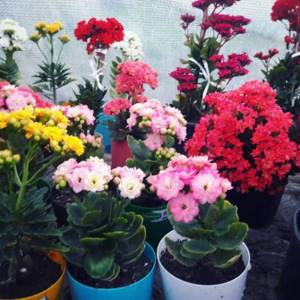
Kalanchoe mix. Photo
It is better to take soil for replanting Kalanchoe with a neutral or slightly acidic environment. The optimal soil composition is leaf and turf soil, and the latter should be twice as much. A little sand and humus is added to them.
There needs to be well-functioning drainage at the bottom of the pot. Kalanchoe grows well using the hydroponic growing method.
Feeding and fertilizer
To grow Kalanchoe at home, you can buy special fertilizers for succulents. The plant should be fertilized once a month in spring and summer, and as winter approaches, reduce this amount. In winter, Kalanchoe does not need feeding at all.
Replanting Kalanchoe
Carried out as needed. Typically, young plants need to be replanted once a year, and older plants less often - once every two to three years. It is advisable to replant Kalanchoe in the spring after flowering.
How to prune Kalanchoe
After Kalanchoe stops blooming, the plant's stems need to be pruned to maintain a beautiful appearance. Otherwise, as they grow, they begin to bend, their nutrition is disrupted and the stems gradually dry out. Long shoots can be used as cuttings for further propagation.
Rest period
In Kalanchoe it is weakly expressed and occurs at the end of winter after flowering. The plant must be placed in a place where it does not receive direct sunlight.
How to make Kalanchoe bloom
After the Kalanchoe flowering has ended, the plant needs to be prepared for the next one. To do this, it is necessary to take care of Kalanchoe at home: cut off all excess and old shoots, and pinch the leaves on top of young ones. This manipulation should be repeated after the third pair of leaves has appeared on the shoot. Just before the beginning of the flowering period, the last pinching is carried out.
In order to make Kalanchoe bloom, you can perform “shock therapy”. Flowering is necessary for reproduction, and it occurs when conditions are unsuitable for the plant (as a need to survive). The plant is placed in a cool and dark place for three weeks without watering it. Then it is placed in its original place, gradually introducing watering and fertilizers back. Within a short time you can see the plant blooming.
Watering
Kalanchoe does not need a lot of moisture. Its fleshy, succulent leaves and stems contain enough moisture for the plant to develop normally and not dry out. It is enough to water several times a week in the hot season and much less often in the cold season. The main thing is that the soil has time to dry out between moistenings, so that water does not accumulate. Otherwise, mold will form, which can destroy the plant.
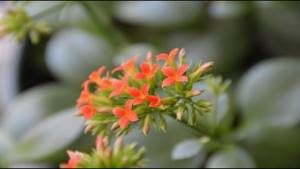
It is also worth paying attention to the leaves. When there is fluff on their surface, you cannot spray Kalanchoe. Water should not get on the leaves. When the surface is smooth and shiny, you need to periodically wash off dust and dirt from them with warm water.
